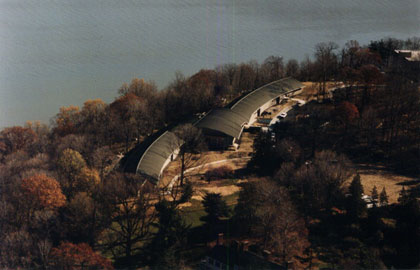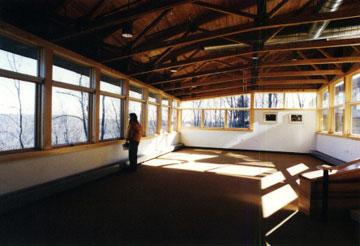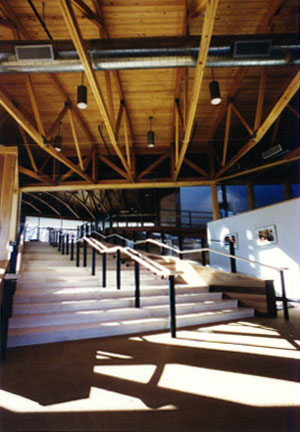
|
|
Aerial view of the new Monell Building on the Lamont-Doherty Earth Observatory campus.
|
This winter, Columbia University opens the Monell Building for international climate research at its Lamont-Doherty Earth Observatory campus in Palisades, N.Y. Built along the rocky Palisades Cliffs 500 feet above the Hudson River, the one-story building slopes and curves along the natural contours of the cliffside for nearly the length of two football fields, in harmony with the landscape of soaring trees and rock outcroppings behind a cedar and stone facade. To take advantage of abundant natural light and ventilation on the site, the architects designed a clerestory window along its entire 562-foot length, allowing for reduced energy needs in three seasons and creating airy and light-filled classrooms, offices, laboratories and conference space.
Located at Columbia's 145-acre earth sciences facility 20 miles north of New York City, the Monell Building will house the Lamont-Doherty director's office and the International Research Institute for Climate Prediction, whose researchers study climate variations and their impact on society and the economies of regions vulnerable to fluctuating and damaging weather patterns.
Built at a cost of $12.25 million, the 27,000-square-foot Monell Building was designed by Rafael Viñoly Architects, the internationally recognized firm with offices in New York, Tokyo and Buenos Aires. The building -- the first to be built on the Lamont-Doherty campus in 25 years -- was financed in part by a generous grant from the Ambrose Monell Foundation, named for a Columbia graduate who died in 1922.
The Viñoly architectural team produced a design premised upon preserving the natural beauty of the Lamont-Doherty campus with its panoramic views of the Hudson River and Westchester County to the east, and on closely integrating the building to the exceptional characteristics of the site -- its strong light, sloping ridge line, dramatic height and airiness. Materials used on the outside were chosen to complement the landscape and to minimize its impact on the overall view of the majestic Palisades from across the Hudson.

|
|
View of the Hudson River from the lounge in the new Monell Building.
|
"The building form emerges from the topography of the site and the extraordinary quality of the landscape," said Rafael Viñoly, the principle architect. "The double curavature roof brings natural light to a central path of distribution. The design of the building uses the same materials that were removed to generate the site: wood and stone."
The Monell Building is included among $719 million in capital construction projects begun by Columbia since 1994 under the leadership of University President George Rupp. Construction began in October, 1998 and the building was completed in November, 1999, dedicated in December, and opened in January.
The building is made up of two single-story wings, faced with field- and flagstones and cedar siding, reinforcing the natural character of the site. The two wings sprawl along the cliffside north to south, meeting at a central point to form a two-tiered central lobby, which offers dramatic views. This light-filled gathering space, with a soaring wood-trussed ceiling and views of the river and Westchester County, cuts across the building from west to east and extends down the cliffside from a sweeping staircase leading to a lounge and exterior deck. Adjacent to the main entrance is the 200-seat Conference Hall, with up-to-the-minute video conferencing capabilities to bring scientists from around the globe together at the Columbia facility. Instead of a wall, the rear of the stage is a huge picture window, which provides a stunning view of the grounds and majestic beech and oak trees on the original Thomas Lamont family estate designed by the Frederick Law Olmsted architectural landscape firm.
The roof is formed of simple wooden trusses placed upon a series of sinuous curved steel beams running north to south. Each wing has two overlapping curved roof sections, one slightly smaller and lower than the other. Where they meet in the center, there is a continuous clerestory window that enhances natural light and can be opened electronically to take advantage of natural breezes on the site and reduce air-conditioning needs in late spring, summer and early fall, according to Charles Blomberg, the project manager for Rafael Viñoly Architects and designer of the window. The window design, he said, purposely allows climate researchers to "interact with the weather."

|
|
Stairs descending from the two-tiered central lobby in the new Monell Building.
|
Fifty offices for senior researchers are arranged in six groups along the eastern side of the building, providing river views. Conference rooms, laboratories and support space are arranged to the west. At either end are the director's offices for the International Research Institute for Climate Prediction and Lamont-Doherty.
The institute's major scientific concerns are the El Niño phenomemon -- the warming of Pacific equatorial waters, that affects climate worldwide and has had a devastating impact in the developing world -- and La Niña, the cooling phenomenon. The institute, whose work is carried out by 80 to 85 researchers, administrators and post-doctoral fellows, is a cooperative partnership between Columbia and the U.S. National Oceanic and Atmospheric Administration's Global Change Research Program. The institute makes regional climate forecasts available to policymakers worldwide, providing an essential tool in long-term planning for agriculture, water resources, public health and emergency preparedness. Antonio Divino Moura is director of the institute. He was formerly chief scientist of the National Oceanic and Atmospheric Administration's Office of Global Programs and director general of the Brazilian Meteorological Service.
"This wonderful building is an incubator, a place where physical, biological and social scientists will meet to forge a new type of science, one that understands how to forecast future climate and what that capability means," said Columbia Executive Vice Provost Michael Crow.
Lamont-Doherty, part of the Columbia Earth Institute, provides facilities and resources for graduate and postgraduate research in the earth sciences. Researchers at the Observatory study natural phenomena in areas around the world -- as nearby as the Hudson River, where investigations of the river's ecology are performed, and as far away as the Antarctic Ocean, where scholars analyze sea-ice formation. Today, the Observatory employs a staff of 550 and maintains a state-of-the-art oceangoing research vessel, the Maurice Ewing.
|
